/Vehicles/Axis/Germany/05-Sturmpanzers/Brummbar/File/Sturmpanzer4-Brummbar.htm | Up-dated: 19-12-2020
Sturmpanzer IV Assault Gun
Début 1942, Alkett avec Krupp fut commissionnépour réaliser un nouveau Sturmpanzer. Alkett devait concevoir une superstructure inclinée armée de l'obusier d'assaut de 150 mm StuH 43 L/12 (mis au point par Skoda pour le canon d'assaut sIG 33). Cette superstructure devait être montée sur châssis standard de Panzerkampfwagen IV modifié par Krupp. Vers la mi octobre 1942, Speer présenta les plans d'un nouveau Sturmpanzer à Adolf Hitler. Le Führer passa une commande de 40 à 60 de ces nouveaux véhicules qui devaient être prêts pour le printemps 1943. Hitler proposa également l'utilisation d'un mortier de 210 mm ou de 220 mm, mais cette version ne fut jamais produite. En février 1943, Skoda réalisa un prototype en bois du nouveau Sturmpanzer IV ou Sturmpanzer 43. Le véhicule fut officiellement design(Sd.Kfz.166- Sturmgeschütz IV mit 15 cm StuH 43).
At the beginning of 1942, Alkett with Krupp was commissioned to carry out new Sturmpanzer. Alkett was to design a tilted superstructure armed with the assault howitzer of 150 mm StuH 43 L/12 (developed by Skoda for the assault gun sIG 33). This superstructure was to be assembled on standard chassis of Panzerkampfwagen IV modified by Krupp. About the semi October 1942, Speer presented the plans of new Sturmpanzer at Adolf Hitler. Führer placed an order from 40 to 60 of these new vehicles which were to be ready for spring 1943. Hitler also proposed the use of a mortar of 210 mm or 220 mm, but this version was never produced. In February 1943, Skoda produced a wooden prototype of new Sturmpanzer IV or Sturmpanzer 43. The vehicle was officially designed (Sd.Kfz.166- Sturmgeschütz IV put 15 cm StuH 43).
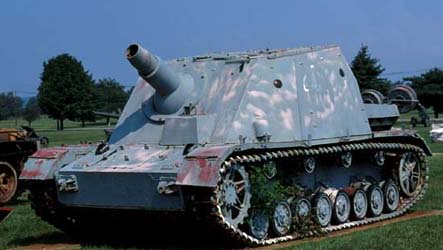 |
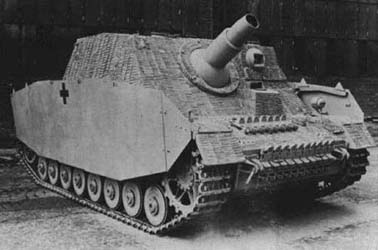 |
Sturmpanzer IV (Frühe Produktion Modell)
|
Sturmpanzer IV (Spätes Produktion Modell) |
src: Site Copyright
1993-2004 Masa Narita |
src: Site www.wwiivehicles.com |
En mars 1943, les six premiers spécimens furent réalisés et vers la fin avril, 40 autres ont été produits. Les 14 derniers furent produits en mai 1943, pour complèter la commande initial. De nouveaux châssis (fournis par Nibelungenwerke), à partir de châssis récupérés furent employés pour effectuer la conversion (environ 52 nouveaux châssis d'Ausf G et huit châssis d'Ausf.E et d'Ausf.F récupérés). Pour plus d'économie on décida d'utiliser seulement des châssis récupérés pour les futurs spécimens. Les usines Heereszeugamt Wien (dépôt d'armée à Vienne) Saurerwerke et Simmering-Graz-Pauker furent également mises à contribution. Mi mai 1943, Sturmpanzer IV fut officiellement présenté aux leaders du troisième Reich à la base militaire d'Arys (Orzysz) en Prusse orientale. La production en série devait commencer en mai 1943, mais les premiers véhicules furent livrés seulement à compter de novembre de 1943 en raison du retard de la livraison des châssis.
In March 1943, the first six specimens were carried out and towards the end April, 40 others were produced. The 14 last will be carried out in May 1943, to satisfy the initial order. New chassis (provided by Nibelungenwerke), from recovered chassis were used torealize the conversion (52 new chassis of Ausf G and eight chassis of Ausf.E and Ausf.F recovered). For more economy it will be decided of more used only recovered chassis for the future specimens. The firms of Heereszeugamt Wien (deposit of army in Vienna) Saurerwerke and Simmering-Graz-Pauker were also put at part. On mid May 1943, Sturmpanzer IV was officially presented at the heads of third Reich at the military base of Arys (Orzysz) in Eastern Prussia. The mass production was to begin in May 1943, but the first vehicles were delivered only as from November of 1943 because of a delay of delivery of chassis.
150
mm StuH 43 L/12 Penetration of a shielding plate (mm) under a plunging angle of 30° |
|||||||
Ammo |
Weight |
Velocity |
100
m |
500 m |
1000
m |
1500 m |
2000
m |
| GR 39 H1/A | 25 kg |
280 m/s |
? |
178 |
167 |
157 |
148 |
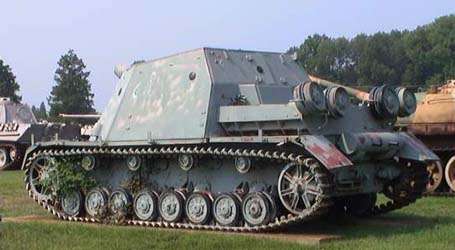 |
 |
Early
(Aberdeen Museum) |
|
|
|
|
Le Sturmpanzer IV de début de production souffrait d'un problème de poids, causé par le recul et le poids (1850 kg) du 150 mm StuH 43 L/12 inadaptés au châssis du Panzerkampfwagen IV. Ces véhicules avaient également des problèmes de transmission et étaient sous-motorisés ce qui induisait une consommation trop élevée. De plus le manque de mitrailleuse d'appoint en faisait des cibles faciles pour les sections anti-char de l'infanterie adverse. Une mitraillette MP 40 était embarquée à l'intérieur de la superstructure et était mise à feu par les sabords de tir au pistolet latéraux de la superstructure. Ces véhicules embarquaient un équipage de quatre hommes, le chargeur étant également opérateur radio. Le pilote au début était équipé d'un épiscope Fahrersehklappe 80 adapté du char Tigre.
Sturmpanzer IV of early production suffered from a problem of weight, caused by the retreat and the weight (1850 kg) of the 150 mm StuH 43 L/12 misfits to the chassis of Panzerkampfwagen IV. These vehicles also had problems of transmission and were under-motorized what induced a too high consumption. Moreover the lack of auxiliary machine-gun made of them easy targets for the anti-tank sections of the opposing infantry. A machine-gun MP 40 was embarked inside the superstructure and was fired by the side ports of pistol shooting of the superstructure. These vehicles took on board a crew of four men, the loader being also a radio operator operator. The pilot at the beginning was equipped with a episcope Fahrersehklappe 80 adapted of the Tiger tank.
 |
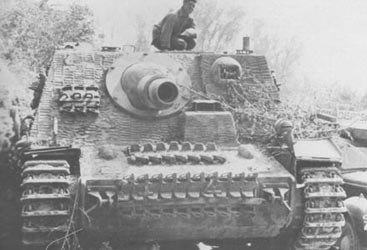 |
src: Site www.wwiivehicles.com |
src: Tank Illustrated n°9
|
Dès décembre 1943, une nouvelle version du 150 mm, plus légère, le StuH 43/1 L/12 sera installée et la superstructure allégée pour gagner du poids. Le même mois la production de la deuxième série débuta et 80 exemplaires furent construits. La position du pilote avait été retravaillée mais le gros problème du Sturmpanzer IV, le poids n'avait pas été véritablement corrigé. En janvier 1944, Sturmpanzer IV a été officiellement baptisé Sturmpanzer IV Brummbär (Grizzly).
Vers la mi 1944, la superstructure fut encore remodelée. La production continua jusqu' en mars 1945 et une troisième et quatrième série furent produites avec un total de 166 exemplaires. Les derniers modèles ou Abschlusserie étaient dotés d'un MG 34 de caisse montée sur rotule (Kugelblende 80 montage pour blindage de 80 mm) montée sur une saillie dans le coin supérieur gauche de la plaque frontale de la superstructure. Le collier du canon fut également modifié, une coupole provenant du StuG III Ausf G (avec support pour MG 34 anti-aérienne) et des Schürzen seront également installés et la pâte anti-magnétique Zimmerit utilisé. Ces véhicules était de plus petit taille que les modèles d'origine. Bien mieux conçus ces derniers modèles se révélèrent être des armes pertinentes et efficaces. Notons que ces modèles utilisaient des châssis de Panzerkampfwagen IV Ausf H (avec un ou deux paires de galets en acier de chaque côté) et d'Ausf J (avec tout des galets en acier).
From December 1943, a new version of the 150 mm, lighter, StuH 43/1 L/12 will be installed and the superstructure reduced to gain weight. The same month the production of the second series began and 80 specimens were built. The position of the pilot had been worked over again but the big problem of Sturmpanzer IV, the weight had not been truly corrected. In January 1944, Sturmpanzer IV was officially baptized Sturmpanzer IV Brummbär (Grizzly).
About mid 1944, the superstructure was still reorganized. The production continued until March 1945 and one third and fourth series were produced with a total of 166 specimens. The last models or Abschlusserie were equipped with a MG 34 of hull assembled on ball (Kugelblende 80 mount for shielding of 80 mm) mounted on a bulge in the left higher corner of the frontal plate of the superstructure. The collar of the gun was also modified, a cupola coming from StuG III Ausf G (with support for anti-aircraft MG 34 ) and Schürzen will be also installed and the antimagnetic paste Zimmerit used. These vehicles was smaller than the models of origin. Well better conceived these last models proved to be relevant and effective weapons. Let us note that these models used frames of Panzerkampfwagen IV Ausf H (with one or two pairs of any steel road wheels on each side) and of Ausf J (with all any steel road wheels).
Seulement 38 coups de 150 mm pouvaient être transportés dans l'espace réduit de la superstructure. Si au départ des munitions de 150 mm pesant 25 kg étaient utilisées, des projectiles anti-char de 38 kg plus puissants seront par la suite préférés. L'obusier d'assaut était monté (légèrement excentré sur la droite) sur rotule dans la plaque frontale épaisse de 100 mm. Celui-ci était équipé d'une lunette de visée Sfl.Z.F.1a (Selbstfahrlafetten-Zielfernrohr) (5x8) et avait un champ de tir vertical allant de -8 à +30 degrés et un champ de tir horizontal de -15° à +15°. L'équipage dans les modèles de fin de production était composé de cinq hommes: le commandant, assis derrière l'obusier, deux chargeurs, un tireur et un pilote, assis dans le compartiment avant.
En tout quatre série furent produites, de mars 1943 à mars 1945, et 298-306 Sturmpanzer IVs furent produits. Le Sturmpanzer IV Brummbär était une développée pour des combats de rues. Il était très efficace contre des positions retranchées d'infanterie, les bâtiments et presque n'importe quel ouvrages militaires. Il servit également comme véhicule de support pour les unités panzergrenadier et d'infanterie. Le Sturmpanzer fut familièrement baptisé "Stupa". Certains véhicules de mi et de fin de production seront utilisés comme véhicules de commandement, Bef.Stu.Pz.IV (Befehlsturmpanzer IV) et équipées des radios et des antennes supplémentaires. Krupp pensa employer le châssis et la superstructure du Brummbär pour créer un Jagdpanzer IV armé du 88 mm Pak 43 L/71, mais seulement un prototype fut produit.
Only 38 rounds of 150 mm could be transported in the reduced space of the superstructure. If at the beginning of the ammunition of 150 mm weighing 25 kg were used, of anti-tank rounds of 38 kg more powerful will be preferred thereafter. The assault howitzer was assembled (slightly on the right) on ball mount in the thick frontal plate of 100 mm. This one was equipped with a sight tube Sfl.Z.F.1a (Selbstfahrlafetten-Zielfernrohr) (5x8) and had a vertical field of fire going from -8 to +30 degrees and a horizontal field of fire from -15° to +15°. The crew in the models of late production was composed of five men: the commander, sitted behind the howitzer, two loaders, a gunner and a pilot, sitted in the front compartment.
In all four series were produced, from March 1943 to March 1945, and 298-306 Sturmpanzer were produced. Sturmpanzer IV Brummbär one was developed for street battles. It was very effective counters cut off positions of infantry, the buildings and almost any fortifications. It was also useful like support vehicle for the panzergrenadier and infantry units. Sturmpanzer was familiarly baptized "Stupa". Certain vehicles of mid and late production will be used like command vehicles, Bef.Stu.Pz.IV (Befehlsturmpanzer IV) and equipped with additional radio and antenna. Krupp thought of using the chassis and the superstructure of Brummbär to create Jagdpanzer IV armed with the 88 mm Pak 43 L/71, but only one prototype was produced.
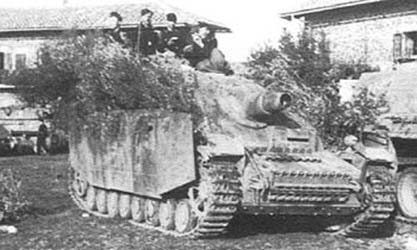 |
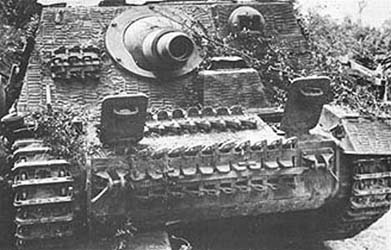 |
Stupa abondamment camouflé sur le front
italien. |
Stupa avec finition de Zimmerit. |
| Stupa abundantly camouflaged on the Italian front |
Stupa with Zimmerit cover. |
src: Site Panzer
Page von Reitsch |
src: Site Panzer
Page von Reitsch |
Les Sturmpanzer IVs furent versés dans des Sturmpanzerabteilungen composés chacun de 45 Sturmpanzer IVs accompagnés de 85 autres véhicules (SdKfz.9...) et 611 officiers et soldats. La première unité fut formée en avril 1943. Le Sturmpanzerabteilung 216 fut transféré dans la région d'Amiens en France pour assurer la formation des équipages. L'unité fut envoyée le 10 juin 1943 sur le front orientale et connu son baptême du feu au sein du 656e sPanzerjäger en tant qu'élément du groupe d'armée Mitte (centre) à Koursk (été 1943). La plupart des Sturmpanzer IV de début de production seront perdus lors de la bataille du saillant de Koursk ainsi qu'à Kharkov et Dneprstroy. Après Koursk, l'unité sera reconstituée et de retour au combat en septembre 1943. Le Sturmpanzerabteilung 216 combattit en Russie jusqu' à la mi décembre 1943, et sera de nouveau renvoyé en Allemagne pour être reconstitué. En février 1944, l'unité sera transférée en Italie, dans la région d'Anzio et de Nettuno. Le 216 resta Italie jusqu' en avril 1945, lorsque le derniers Brummbärs furent détruits par leurs équipages près du lac de Garde.
Le Sturmpanzerabteilung 217 fut formé d'avril à juin 1944 à Grafenwohr En juillet 1944, il fut envoyé en Normandie au sud-est de Caen. Une partie fut détruite à Falaise, et les rescapés de retirèrent en Hollande et participèrent à la défense d'Aix-la-Chapelle. Le, Sturmpanzerabteilung 217 participa également à l'offensive dans Ardennes (hiver 44-45). Le 217 fit finalement reddition dans la Rhür en avril 1945.
En août 1944, deux compagnies indépendantes furent formées, la Sturmpanzer-Kompanie z.b.V. 218 et la Sturmpanzer-Kompanie z.b.V. 2/218. Ces deux compagnies étaient équipées de 10 Brummbärs chacune. La 218 fut envoyée à Varsovie le 13 août au sein du groupe de combat Reinefarth et s'opposa au soulèvement de la ville. L'unité demeura en Pologne et devait faire en principe partie de nouveau Sturmpanzerabteilung 218 dont la constitution avait débuté en janvier 1945. Cependant une nouvelle offensive soviétique mis à mal la compagnie et les restes de l'unité furent versés dans le Kampfgruppe Grossdeutschland. La Sturmpanzer-Kompanie z.b.V. 2/218 quant à elle fut envoyée dans la région parisienne en août 1944, puis...?.
Sturmpanzers were versed in Sturmpanzerabteilungen composed with 45 Sturmpanzers accompanied by 85 other vehicles (SdKfz.9...) and 611 officers and soldiers. The first unit was formed in April 1943. Sturmpanzerabteilung 216 was transferred in the area from Amiens in France to ensure the training of the crews. The unit was sent on June 10, 1943 on the Eastern front and known its baptism of fire within the 656th sPanzerjäger as an element of the group of army Mitte (center) at Koursk (summer 1943). The majority of Sturmpanzer IV of early production will be lost at the time of the battle of Koursk saillent like in Kharkov and Dneprstroy. After Koursk, the unit will be reconstituted and returned to the combat in September 1943. Sturmpanzerabteilung 216 fought in Russia until mid December 1943, and will again be returned to Germany to be reconstituted. In February 1944, the unit will be transferred in Italy, in the area of Anzio and Nettuno. The 216 remained Italy until April 1945, when the last Brummbärs were destroyed by their crews close to Lake Garda.
Sturmpanzerabteilung 217 was formed from April to June 1944 in Grafenwohr. In July 1944, it was sent in Normandy to the south-east of Caen. A part was destroyed in Falaise, and survivors withdrew in Holland and took part in the defense of Aachen. Sturmpanzerabteilung 217 also took part in the offensive in the Ardennes (winter 44-45). The 217 made finally rendering in Rhür in April 1945.
In August 1944, two independent companies were formed, Sturmpanzer-Kompanie z.b.V. 218 and Sturmpanzer-Kompanie z.b.V. 2/218. These two companies were equipped with 10 Brummbärs each one. The 218 was sent in Warsaw on August 13 within the combat group of Reinefarth and was opposed to the revolt of the city. The unit remained in Poland and was to again form in theory part of Sturmpanzerabteilung 218 from which the constitution had begun in January 1945. However a new Soviet offensive put at evil the company and the remainders of the unit were versed in Kampfgruppe Grossdeutschland. Sturmpanzer-Kompanie z.b.V. 2/218 as for it was sent in the Paris area in August 1944, then...?.
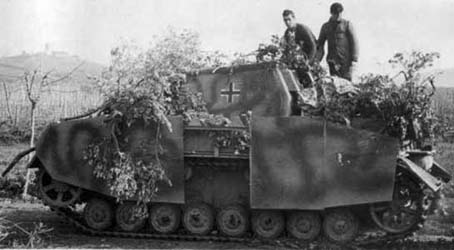 |
Stupa en vadrouille. |
| Stupa in ramble. |
src: Site
"Panzerwaffe"
|
Le Sturmpanzerabteilung 218 dont la formation débuta en janvier 1945 fut fin prêt pour le combat en mars avec un effectif de 43 Brummbärs. En avril, l'unité sera convertie en Panzer-Jaeger-Verband.
En septembre 1944, le Sturmpanzerabteilung 219 fut constitué à Dollersheim. En décembre, le 219 sera envoyé dans la région du lac Velencei en Hongrie. En janvier de 1945, le 219 au sein de la 23e Panzerdivision participa aux affrontements de la région de Budapest. En mars, sans aucun Brummbärs, l'unité fut envoyé en Tchécoslovaquie, où elle fut reconstituée avec 10 Brummbärs En avril, elle fut déplacée sans équipement à Waidhofen et est allée grossir la Panzer-Jagd-Brigade "Trumpa".
Sturmpanzerabteilung 218 from which the formation began in January 1945 was ready for the combat in March with a strength of 43 Brummbärs. Into April, the unit will be converted into Panzer-Jaeger-Verband.
In September 1944, Sturmpanzerabteilung 219 was formed in Dollersheim. In December, the 219 will be sent in the area of the lake Velencei in Hungary. January of 1945, the 219 within 23rd Panzerdivision took part in the confrontations of the area of Budapest. In March, without any Brummbärs, the unit was sent in Czechoslovakia, where it was reconstituted with 10 Brummbärs In April, it was moved without equipment at Waidhofen and went to enlarge the Panzer-Jagd-Brigade "Trumpa".
 |
Stupa totalement détruit. |
Completly estroyed Stupa. |
src:
Site
"Panzerwaffe" |
Data |
Drawings |
Sources:
- Connaissance de l'Histoire (Hachette) - N°17 - " Les chars de combat allemands 39-45"
- Connaissance de l'Histoire (Hachette) - N°5 - " Véhicules blindés allemands 39-45"
- Les Blindés de la Seconde Guerre Mondiale (Atlas)
- Sturmartillerie & Panzerjäger 1939-1945 (Osprey Military) - New Vanguard N°34
- Site "Achtung Panzer" - http://www.achtungpanzer.com
- Site "WWII Vehicles" - http://www.wwiivehicles.com
- Site "Second World War Armour" - http://www.onwar.com/tanks/index.htm
/Btn-off.jpg)
/Bt-off.jpg)